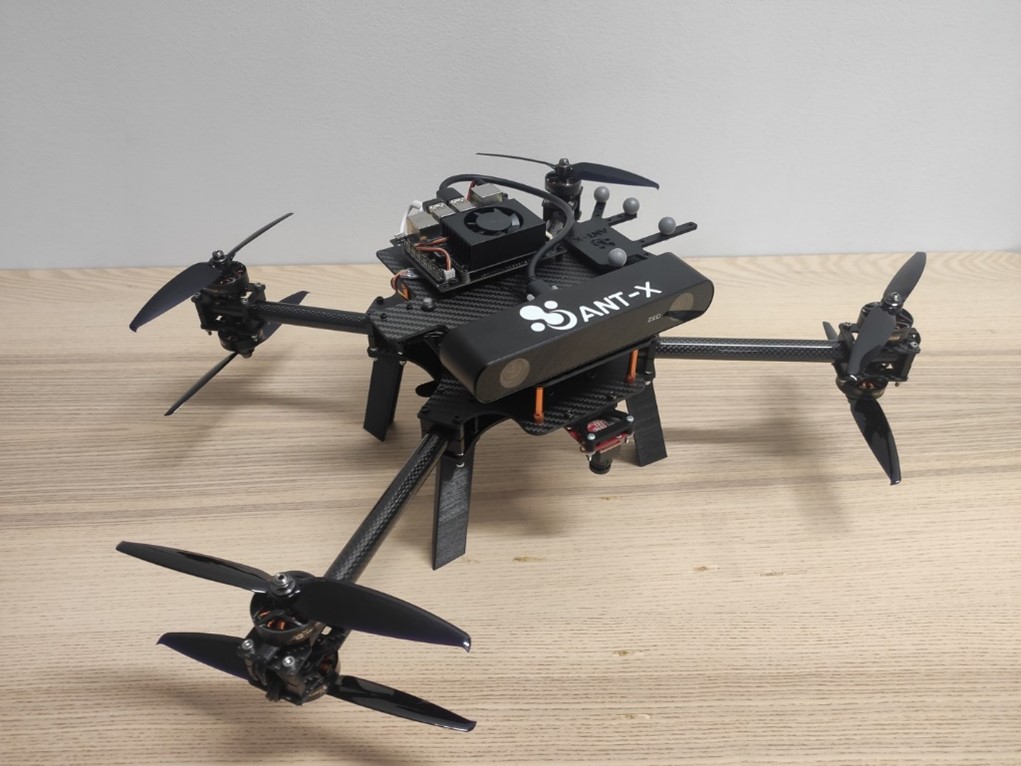Startup Spotlight: Drone Startup Bridges the Gap Between Academia and Industry
This startup feature was written by Michael Hayes from MathWorks Startup Marketing Team.
The startup story of ANT-X, like so many others, has its origins in a university. The startup is a spin-off from the drone laboratory of the Department of Aerospace Science and Technology at Politecnico di Milano, Italy’s largest technical university. The CEO, Simone Panza, and the other ANT-X cofounders came together at the university “doing research on guidance, navigation, and control of drones while gaining experience in designing and prototyping drones from scratch.” Before long, the team realized their expertise addressed an underserved opportunity in the burgeoning drone industry.
As researchers at Politecnico di Milano, the ANT-X team was availed one of the most advanced and best established drone laboratories at any European university. Indeed, the to-be cofounders of ANT-X contributed to setting up the laboratory facility from scratch and boot-strapping the first experimental activities in the lab.
While drone research groups exist at many technical universities, most have limited space for testing or may work exclusively in a simulated environment.
The young team set out to address these limitations by custom building compact, drones and complementary software products to fit the physical space and technological capabilities of university laboratories, thus providing a ready-to-use laboratory solution to academic users.

ROG-X – a platform designed for experimental research activity on autonomous guidance and navigation based on computer vision. Image courtesy of ANT-X.
A central feature of ANT-X’s offering is that their drones operate on software that students are likely to already have familiarity with. Specifically, the drones are programmed in open-source tools (ROS and PX4) and feature custom software products offering inputs from MATLAB or Simulink. The familiar open-source framework provides transparency and opens access for students as Simone explains:
Imagine that you are an engineering student and you would like to program a drone even at very low level. This is something that you usually cannot do with commercial drones. But with our drones you are able to work in an open-source environment.
ANT-X also offers proprietary software tools to supplement their open-source platforms, including DroneCmd and Simulink to PX4 (SLXtoPX4). DroneCmd is an API developed in MATLAB that allows user to receive telemetry data in MATLAB and simultaneously input commands. In this way the user can program the drone to automatically execute missions in a repeatable way by writing simple MATLAB scripts. On the other hand, SLXtoPX4 allows the user to design a custom controller model in Simulink and automatically generate code from the controller model This tool helps bridging the gap between controller design and implementation by exploiting the powerful graphical user interface of Simulink. Both tools enable students and researchers to develop and execute code from an interface with which they are likely to be familiar without the need to hand code.
ANT-X laboratory setup with integration of MATLAB and Simulink. Video courtesy of ANT-X.
The integration of industry vetted tools such as MATLAB and Simulink with broader open-source platforms like ROS and PX4 was born in part from the academic environment in which the startup formed. Simone and his team were already users of MATLAB and Simulink at Politecnico di Milano. As focus shifted from academic research to commercialization, the team determined that MathWorks tools would remain foundational to their products. It became clear, however, that the university’s academic license would no longer cover their new venture. Simone recalls:
Both as students and as researchers, we had been using MathWorks products for many years, so we decided to move on using the same products even as a spinoff company. In this sense, it was useful to be incubated in Polihub.
Polihub is the deep tech startup accelerator at Politecnico di Milano. The fledgling ANT-X enrolled at Polihub and soon after explored how they might leverage their accelerator to access the tools they needed. In fact, it was the ANT-X team who first introduced MathWorks Accelerator program to Polihub. Via this program, MathWorks partners with accelerators to supply tools to incubated startups at no cost. The Polihub team agreed that sponsorship would prove valuable not only to ANT-X but much of their startup portfolio and a partnership was quickly reached. As soon as the partnership was finalized, ANT-X was among the first startups to access the sponsored tools.
With support from Polihub and its partners, ANT-X was able to transition from research group to profitable startup company in just a few years. Here too MathWorks tools brought value:
We develop new drones in non-conventional configurations, for example, where the rotors are not parallel to each other, but they are tilted in different orientations. MATLAB and Simulink help a lot in accelerating the development cycle, implementation, flight testing, and correction because we skip the coding part. We can design a model of the controller and deploy, so this makes the testing much faster.

The ANT-X team during an outdoor flight test session: Mattia Giurato (CTO, left) and Simone Panza (CEO, right). Image courtesy of ANT-X.
As a small and agile but experienced team, ANT-X is well positioned to propose innovative solutions and bring them to market quickly. To date, that market has largely been centered around universities; however, the team has also ventured into the industrial drone market. When asked what’s next for ANT-X, Simone shared an exciting project with potential to disrupt the industrial drone landscape:
Conventional drones are not able to handle stable contact with the external environment. So, we are working on this very innovative project named ARIES to develop a drone which is able to go in contact with objects to carry out NDT (non-destructive-testing) inspections. For example, the object can be a bridge on a highway, or it could be an electrical high voltage line. The ARIES drone can go in contact with the object and push against it, while maintaining stable flight. In this way you can place a sensor on the object to collect measurements, and at the same time increase safety by keeping the human operator on the ground. So, this new capability to interact with the environment is going to be a major revolution in the drone market in coming years and so far we are among the first pioneers.

The ARIES drone developed by ANT-X for NDT inspections; in the picture, a contact inspection on a high voltage powerline. Image courtesy of ANT-X.
Simone expects many such opportunities as drones become increasingly ubiquitous in our day to day lives. His team has no intentions to move away from their roots in academia, but they also see themselves at the vanguard of emerging drone markets. Simone is optimistic about the future of his industry, as he concludes:
All projections indicate that drones are going to be more and more present in our skies in the next few years. So, it’s a market which is growing and it’s good for a startup to invest in this direction.
- Category:
- Startup Spotlights








Comments
To leave a comment, please click here to sign in to your MathWorks Account or create a new one.